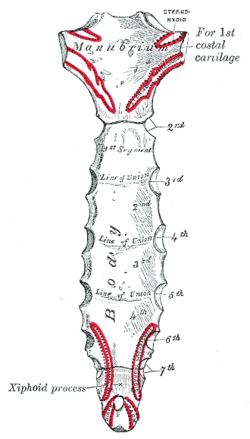Xiphoid process
| Xiphoid process | |
|---|---|

Position of the xiphoid process (shown in red).
|
|

Posterior surface of sternum. (Xiphoid process labeled at bottom.)
|
|
| Details | |
| Identifiers | |
| Latin | processus xiphoideus |
| MeSH | A02.835.232.904.766.825 |
| TA | A02.3.03.007 |
| FMA | 7488 |
|
Anatomical terms of bone
[]
|
|
The xiphoid process /ˈzaɪfɔɪd/, or xiphisternum or metasternum, is a small cartilaginous process (extension) of the lower (inferior) part of the sternum, which is usually ossified in the adult human. It may also be referred to as the ensiform process. Both the Greek derived xiphoid and its Latin equivalent ensiform mean 'swordlike'.
The xiphoid process is considered to be at the level of the 9th thoracic vertebra and the T6 dermatome.
In newborns and young (especially slender) infants, the tip of the xiphoid process may be both seen and felt as a lump just below the sternal notch. By age 15 to 29, the xiphoid usually fuses to the body of the sternum with a fibrous joint. Unlike the synovial articulation of major joints, this is non-movable. Ossification of the xiphoid process occurs around age 40.
The xiphoid process can be naturally , and sometimes perforated. These variances in morphology are inheritable, which can help group family members together when dealing with burial remains. These morphological differences pose no health risk, and are simply a difference in form.
In birds, the xiphoid process is a long structure, often following the direction of the keel.
Much the way the first seven ribs articulate with the sternum, the cartilage in the celiac plexus joins on the xiphoid process, reinforcing it, and indirectly attaches the costal cartilage to the sternum.
Pressure on the xiphoid process should be avoided when administering chest compressions in CPR, as this can cause the xiphoid process to break off, resulting in punctures or lacerations of the diaphragm. Additionally, the liver may be punctured, resulting in lethal hemorrhaging.
...
Wikipedia
